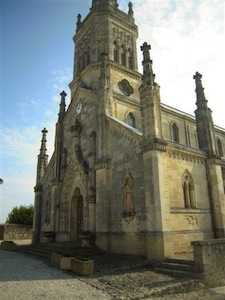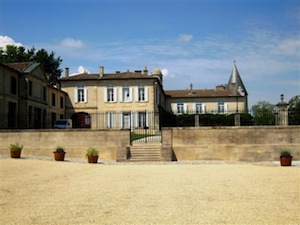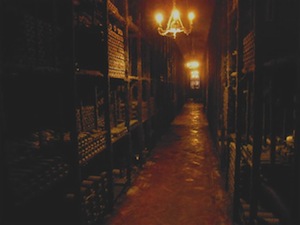Special Feature: Products Sally Recommends
Première Bordeaux - Lundi après-midi
 With the next appointment at 1:30 pm. there was little time for driving to Beychevelle or Pauillac to seek a place for lunch, so I decided to explore the village of Staint-Julien on foot, before my visit to Chateau Leoville Barton. Hunger took a distant second place to the excitement I was feeling. I had spotted a small sign when driving through, which indicated a café was inside an old stone building, fronting the thoroughfare. Walking by, and peering through the dirty window, I noticed chairs and tables with dust so thick it had been eons since food had been served there. Any wonder, this ancient-looking village, except for the cars whisking by on D-2, was eerily lifeless. Across the street was an old cathedral, extremely small in size, yet with cut stone features which made it as unique and compelling as any I had seen. Unfortunately, the doors were locked, blocking my entry. So, I decided to travel south to the visitor’s entrance at Leoville Barton and await my appointment.
With the next appointment at 1:30 pm. there was little time for driving to Beychevelle or Pauillac to seek a place for lunch, so I decided to explore the village of Staint-Julien on foot, before my visit to Chateau Leoville Barton. Hunger took a distant second place to the excitement I was feeling. I had spotted a small sign when driving through, which indicated a café was inside an old stone building, fronting the thoroughfare. Walking by, and peering through the dirty window, I noticed chairs and tables with dust so thick it had been eons since food had been served there. Any wonder, this ancient-looking village, except for the cars whisking by on D-2, was eerily lifeless. Across the street was an old cathedral, extremely small in size, yet with cut stone features which made it as unique and compelling as any I had seen. Unfortunately, the doors were locked, blocking my entry. So, I decided to travel south to the visitor’s entrance at Leoville Barton and await my appointment.
Close to the scheduled time, I entered the facility and met my host, Alexandra. Again, I was the only person scheduled so we began at her convenience. Like many of the others, there were numerous buildings where the wine was created and stored. This Chateau and winery exists on the property of Chateau Langoa-Barton, its sister, across the roadway. Alexandra asked for me to follow her, as we exited the visitor’s office and walked across D-2 for the tour. We ventured through their impressive wooden-staved wine fermentation vats, all founded upon square cut stone floors. Air-conditioned wine storage rooms were illuminated with antique chandeliers. As we walked “Alex” provided a brief history of the properties.
As previously referenced in the history of Leoville Poyferré, a parcel of the Las Cases estate was sold in the early 1800’s, after the property of Marquis de Las-Cases-Beauvoir was confiscated during the French Revolution. It was acquired by Hugh Barton of Barton & Guestier, a noteworthy merchant/négociant business (still in operation today). Barton had acquired the Langoa property in 1821 and the Leoville parcel a few years after the Marquis fled France. The property would remain under family ownership to the present, becoming the longest single-family ownership of a Bordeaux wine estate. In 1986, control passed to Anthony Barton, its current proprietor. The Langoa and Barton estates have a combined 68 hectares under vine, consisting of 72% Cabernet Sauvignon, 20% Merlot and 8% Cabernet Franc. Barton’s track is on the estuary side of D-2.
As we exited the barrel storage warehouse, we entered the room where the tasting was prepared. I was allowed to sample the 1997, 1998, 2009 and 2010 Langoa, along with the 2004, 2009 and 2010 Barton. All were excellent examples of these labels, the Langoa seeming a bit more ready for consumption in the recent vintages. The 2009 samples of both wines were outstanding (exhibiting big fruit and an approachable tannin structure), placing these on my “definitely acquire” list, following my return home.
As the visit concluded, we walked back to the visitor’s center, and I prepared my coordinates calculation for the most anticipated tour of the entire trip… first-growth Chateau Lafite Rothschild. As, Ms. G directed my travel, I noticed that the property was situated on the northwestern edge of Pauillac’s viticulture district, bordering Saint-Estèphe. Approaching this estate, the roadway skirted a large hill, totally under vine, and on the other side, a grand Chateau structure could be seen behind some interestingly painted support buildings. Later, I would find that these structures were the points of access to the labyrinth of caves housing Lafite’s winemaking equipment, barrel wine storage vaults and the private family storage cellar of Baron Eric de Rothschild, the current-day proprietor.
The beautiful property had its own lake for the family’s recreation (the Chateau is a residence) and a large parcel dedicated to gardens of flowers and vegetables. From its size, produce yields would be much more than any extended family living in the Chateau could consume, even if frozen or otherwise preserved. A landscape company had boom lifts on the grounds that day, manicuring each tree to perfection. The famous estate was remarkably open to public access, although there were signs warning about trespassing. Driving in, there were arrow indicators for their visitor’s office. The email confirmation of my visit indicated “3:30 pm. sharp,” so of course, I was waaay early. Cute little Aurore DUPA was in the office awaiting my arrival. She asked me to be seated. Moments later Frederick, their Cellar Master appeared, and again to my delight, “your’s truly” was the only person scheduled for this visit. Before we commenced, he gave me a brief history of the estate.
 Records indicate that as far back as the mid-16th century, the Lafite (French word for “little hill”) property had been farmed. By 1670 it was inherited by the famous Marquis Jacques de Ségur, founder of current day Château Calon-Ségur. Wines from Lafite were treasured by British royalty in the 17th century and later became the preferred vintages in the cellar at Versailles. In the late 1700’s, Lafite began passing from one Dutch négociant owner to another, finally being acquired by the Rothschild family in the late 1860’s. Depression, Phylloxera and war ravaged the estate in the years to come, but by 1945, Baron Elie de Rothschild regained and restored the property, following German control. The torch was passed to Baron Eric in the 1970’s. Today there are 110 hectares under vine, of which 70% is Cabernet Sauvignon, 25% is Merlot, 3% is Cabernet Franc and 2% is Petit Verdot. There are 90 full-timed workers on the estate. At harvest, 250 Bordeaux students are hired as pickers.
Records indicate that as far back as the mid-16th century, the Lafite (French word for “little hill”) property had been farmed. By 1670 it was inherited by the famous Marquis Jacques de Ségur, founder of current day Château Calon-Ségur. Wines from Lafite were treasured by British royalty in the 17th century and later became the preferred vintages in the cellar at Versailles. In the late 1700’s, Lafite began passing from one Dutch négociant owner to another, finally being acquired by the Rothschild family in the late 1860’s. Depression, Phylloxera and war ravaged the estate in the years to come, but by 1945, Baron Elie de Rothschild regained and restored the property, following German control. The torch was passed to Baron Eric in the 1970’s. Today there are 110 hectares under vine, of which 70% is Cabernet Sauvignon, 25% is Merlot, 3% is Cabernet Franc and 2% is Petit Verdot. There are 90 full-timed workers on the estate. At harvest, 250 Bordeaux students are hired as pickers.
We walked outside the office and over to one of the long narrow buildings that I had noticed. It was primarily for equipment storage, but more importantly the access stairway down into the subsurface chambers where winemaking equipment and aging barrels were housed. We toured their impressive collection of wooden, stainless steel and concrete fermentation vats and then proceeded to the vaults where the 2009 and 2010 vintages were stored. A modern designed concrete structured circular room contained a number of barrels which were in the process of being steam-cleaned (these would be utilized only as future storage containers of second label wines). The large room was designed with perfect acoustical properties, enabling musical concert dinners for the Rothschild family and their friends when emptied. It also served as the room where wine would be racked and fined, just before bottling. The circular configuration was determined (by its designer) to yield labor savings, with employees not having to walk as far in a single direction when accessing barrels during this process. I judged it to be more for the amusement and entertainment of the owner, rather than a creation designed for more efficient utilization of an inexpensive work-force.
 We then walked in the direction of the Chateau (still below ground level). Here was the most impressive part of the entire tour. The modern component intersected with the antique wine caves originally built below the Chateau. These housed the family’s private stash of 20,000 bottles of Lafite wines, dating back to 1797. The caves were perfectly dark and dank, with musty dust-covered bottles stacked on either side of their black steel gated walls. The Rothschild’s private sommelier accessed these chambers on a regular basis, selecting appropriate vintages of Lafite for every lunch and dinner (attended by the family and their guests), based on his judgment of best paring characteristics with the fare that the private chef prepared. (I asked Frederick if he had an application for employment that I might fill-out.) New vintages replaced the bottles removed, so that the cellar bottle count remained the same, at all times. Preserving the older wines in this private collection is accomplished every 25 to 30 years. Bottles nearing or exceeding that age are all recorked, utilizing sulfur dioxide to keep air from accessing and damaging the precious fluids.
We then walked in the direction of the Chateau (still below ground level). Here was the most impressive part of the entire tour. The modern component intersected with the antique wine caves originally built below the Chateau. These housed the family’s private stash of 20,000 bottles of Lafite wines, dating back to 1797. The caves were perfectly dark and dank, with musty dust-covered bottles stacked on either side of their black steel gated walls. The Rothschild’s private sommelier accessed these chambers on a regular basis, selecting appropriate vintages of Lafite for every lunch and dinner (attended by the family and their guests), based on his judgment of best paring characteristics with the fare that the private chef prepared. (I asked Frederick if he had an application for employment that I might fill-out.) New vintages replaced the bottles removed, so that the cellar bottle count remained the same, at all times. Preserving the older wines in this private collection is accomplished every 25 to 30 years. Bottles nearing or exceeding that age are all recorked, utilizing sulfur dioxide to keep air from accessing and damaging the precious fluids.
Next we proceeded to a small table which had been set, overlooking the arena shaped vault. There a full glass of 1995 Lafite Rothschild awaited. A blissful few minutes followed that first swirl and sniff. The wine exceeded expectations. We did not barrel taste any of the new product, being aged in that grand subsurface enclosure. I did not bother to ask. Thoughts melted away as perfection in flavor swirled around my tongue. Above the table on the wall a metal plaque had been engraved with these words… Ce n'est pas le vin. C'est Lafite. Enough said.
We took another stairway to the surface, exiting through a different spot in one of the support buildings. With appreciative parting words and a hand shake, I began walking toward my car. The drive away was very slow, as I beheld again my view of the impressive Chateau and its grounds. I programmed my return information into Ms. G, thoughtlessly minding her instructions on the trip back to my evening eatery. What an incredible opportunity this had been… Yet, still more great tales of the final day’s adventures await.
Chateau Leoville Barton
www.leoville-barton.com
Chateau Langoa-Barton Cached - Similar
www.leoville-barton.com
Barton & Guestier
www.barton-guestier.com
Chateau Lafite Rothschild
www.lafite.com
Château Calon-Ségur
Website unavailable
Note: This information was accurate when it was published. Please be sure to confirm all rates and details directly with the businesses in question before making your plans.



